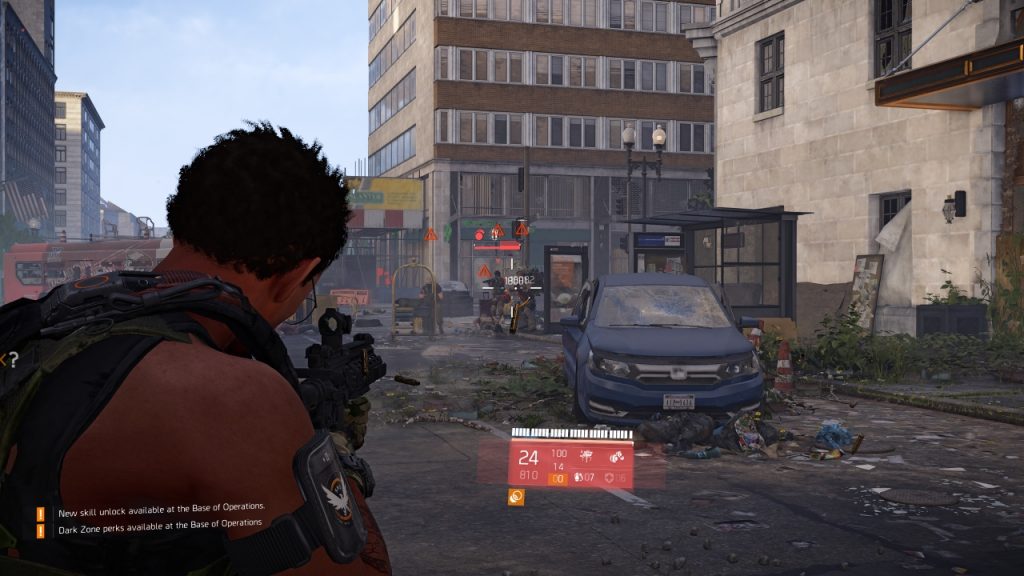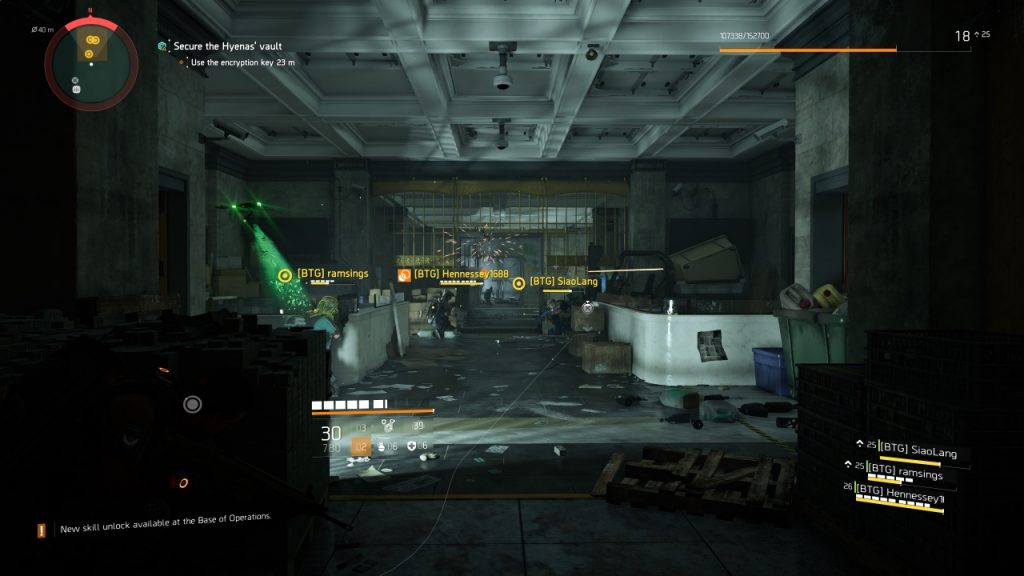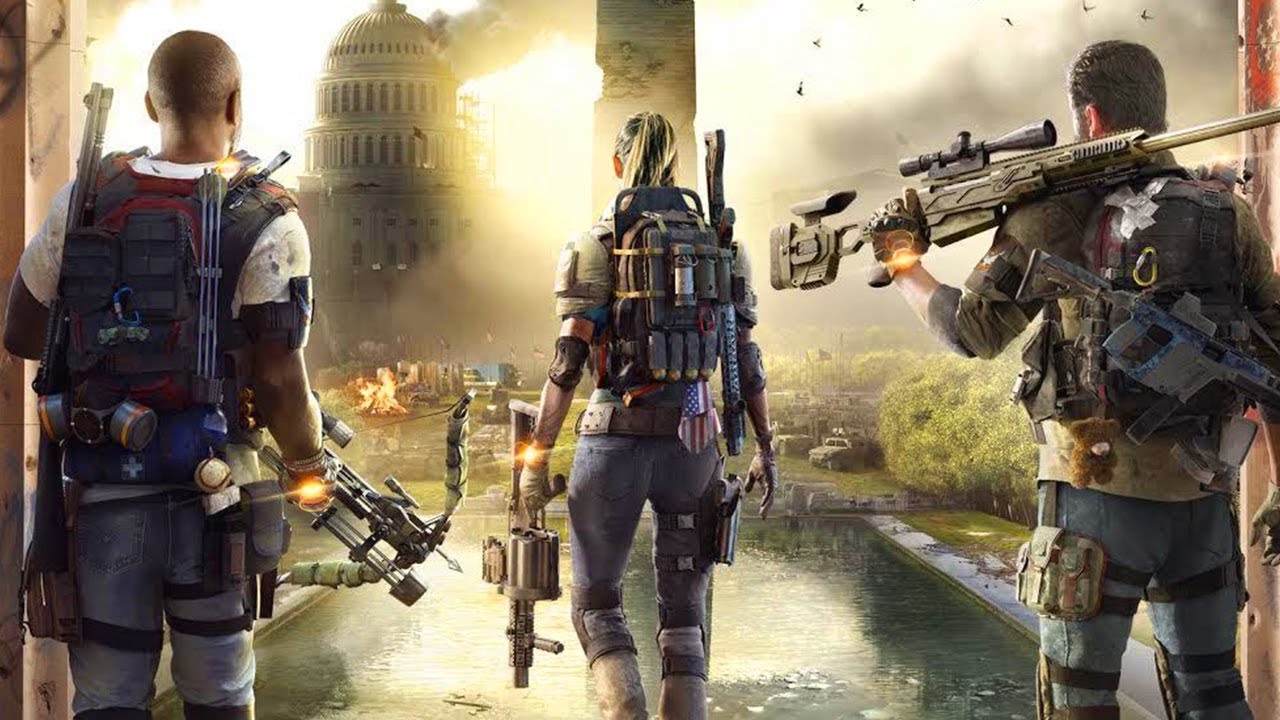Developed By: Massive Entertainment.
Published By: Ubisoft
Platforms: PS4, Xbox One, PC
Reviewed On: PlayStation 4 Pro
[embedyt] https://www.youtube.com/watch?v=Q_kl3rkY9mk&width=720&height=405[/embedyt]
Story
It all began when the Strategic Homeland Division (SHD) network that controls all Division agent’s technology and communication suddenly went dark. You, as the protagonist, were in the middle of a fight defending a civilian settlement from an enemy raid when you suddenly received a distress signal coming from Washington D.C. Upon arriving there, you’d join up with the remaining Joint Task Force (JTF) and learn that most part of Washington is now under the control of 3 warring factions. And, while there are still civilian settlements out there, their fall is only imminent if left on their own. Division 2’s missions would set you on a course of doing what’s necessary to return power and control to the JTF and Civilian Settlements by pushing back the 3 aggressive factions.
If everything sounds exactly as you’ve guessed so far, then it’s because the game’s plot really is predictable, there’s nothing new here at all. Over the course of the game, you will constantly be fed with stories of how things went from bad to worse, and that only you alone can turn the tide to their favour. Although I applaud the efforts invested into this game’s level designs, it’s plot is, however, nothing special. If you expect good storytelling from this game, I’d say Division 2 offers a decent experience at that, but only decent.
Gameplay and Comparison to Division 1
The gameplay experience is where it really shines in Division 2 because even though the story missions could feel like a chore sometimes, but at least the process itself is fun. The said process involves – Shooting, Looting, Modifying, Crafting – and you’d do so in a rinse and repeat manner to get better items so that you could progress to a higher level, and then tiers. Sounds like grinding? That’s because it is! But at least the loot system in this game is generous and as such, you’d always feel like you are progressing.
Division 2 is a tactical shooter game that really punishes anyone who dares to forget the word “tactical” for one second. Rushing towards a group of enemies in solo play is suicidal, and doing so in multiplayer session is frowned upon. While the enemies don’t feel as bullet spongy as they did in Division 1, enemies now are certainly more tactically adept and would employ tactics like flanking maneuvres and lay down suppressing fires. Their tactical prowess seems to increase as the difficulty tiers increases, so they don’t just hit harder and have higher HP, but they are smarter too. I find that I need to shift from cover to cover more often than I needed to in Division 1 to avoid being encircled.
Getting surrounded in this game would certainly mean death, and this is especially true when fighting in the open-world, as enemies in Division 2 spawn more often and therefore, the likelihood of getting anal-ed by an enemy patrol party is high. I used to joke with a colleague that you can’t walk more than 50m in Division 2 without running into an enemy group and this is also true, in many ways, the open-world in this game feels alive and dynamic compared to the empty and cold ruins of Manhattan in Division 1.
The level designs in Division 1 was considerably good but Division 2 took it a notch further with its nicely designed building interiors and the exterior compounds where combat takes place. The involvement of environmental objects like being able to shoot at a water pipe to douse the flame on the floor, and shooting at a junction box to stop a ventilation fan from spinning so that we can go between the blades of the fan to another area, is a refreshing addition to the gameplay. I’ve lost count how many times my friend and I were wowed by the level designs.

End-Game
The end-game, like the name itself suggested, is reserved until after a player reaches level 30 and completed his/her main campaign. After which, your levels will be replaced by Gear Scores which is an average figure of the totaled up value of all individual equipment you are wearing. The game’s world is divided into 4 world tiers, each more difficult than the other and is only unlockable upon completing the end-game missions and strongholds. Each increment in tier level increases the maximum number of gear score you can obtain and as of press time, the maximum obtainable gear score stands at 450, on a World Tier 4. It is worth noting that the only noticeable change as the world tier increases is just the fact that the enemies are now tougher than before, there is no change in the gameplay mechanics at all.
So what do you do in the end-game exactly? Players can choose to replay previously completed missions on a higher difficulty to unlock more blueprints to craft, replay a stronghold at on a higher difficulty, or pretty much replay anything else on a higher difficulty, which is boring. The Raid system is not yet implemented but will feature an 8-players raid when it comes. I only hope it comes with certain mechanics requirement because so far, the game is just asking us to shoot our way to completion, which can be dull after a while.
Other than that, the main attraction in the end-game lies in the open-world itself. The open-world of Division 2 evolves after a player reaches the end-game section and opens up a whole new load of opportunities and new gameplay moment to offer.
Dynamic Open-World.
Let’s talk about the open-world, this is an area that earned the most praises from me – An Open-World that looks and feels alive. There are now more friendly and enemy patrols around going around the city and you’d always run into them, like I said, at least once every 50 meters. Other than the normal patrols, you’d also see enemy escorting crucial supplies to their control-points (small fortresses) and you could actually intercept them and loot those supplies for yourself. Neat eh? Likewise, you could also protect the civilian escorts from bandits. Other than just patrols and escorts, you’d occasionally run into a public execution and can choose to intervene to free the hostages, there’s also enemy propaganda towers that you could hijack for the civilian faction, and there are enemy control-points and fights for territorial control that you can engage in. Put them all into one single pot and brew them, you get a solid open-world filled with activities.
Whatever I said above is only referring to the pre-end-game. What happens after you hit level 30 and finishes the main campaign is a different story altogether. The game introduces a whole new elite faction and it is at this stage of the game that the word “dynamic” really comes into play. Any civilian held control-points you captured prior to the end-game, can now be captured back by other enemy factions. Opening the map would show enemy attacking forces heading towards a friendly control-point, and likewise, friendly forces marching towards an enemy control-point. Control-points can now have difficulty tiers upon reaching World Tier 4, which gives improved set of loots upon completion.
Division 2 has the most active and dynamic open-world environment I’ve ever seen in a video game. I’ve never enjoyed world activities so much as I did in Division 2 and the fun is greater when I play with my friends. Whatever Ubisoft has planned for Division 3, they better maintain this level of open-world design, if not better.
Clan System!
Another thing that I really enjoyed seeing. BunnyGaming was founded by a gaming clan, so as you can imagine, the clan system really sits well with us. Having the clan system really helps people to get together in Division 2, furthermore with the easy to invite and join session functions via the clan roster. The clan system also comes with 2 voice channels where clan members can freely join and talk to each other, the only thing missing here is the system doesn’t inform other clan members when someone has joined the voice chat. I think having such notification in place would keep people informed when someone has joined the voice channel without the need to check channel manually to see if someone’s inside.

The clan system also comes with its own level system, unlocking more function and perks on each level upgrade. Being in a clan unlocks a Clan Vendor, Clan Bounties, and a weekly cache with rewards. All in all, the clan system in Division 2 offers a good player to player interactive experience.
Sound and Audio.
Nothing much to say here except the sound effects from firing a gun is reasonably good. Explosions sound scary. You would hear gunfights happening from a distant and it sounds believable. One BIG complain I have here is the fact that the human speech volume is too LOW compared to the gunfires. The clan system should pop a subtle notification informing other clan members when someone has joined the clan voice channel, this is a simple but meaningful addition that encourages players to interact with each other.
Graphics.
Division 2 looks great but is frequently plagued with the slow rendering of objects, making them look blurred for a while before properly taking shape. I guess this is the tradeoff if you want a faster loading time but I don’t mind it one bit. Compared to Anthem and Metro Exodus, the loading time in Division 2 is a godsend. While Division 2 did not include the entire city layout of the real Washington D.C, but for the part that it represents, the Washington city in-game is actually built to a 1:1 scale of the real city, which is a good treat for virtual tourist like myself who’ve never been to that part of the world.
For the PlayStation 4 Pro users, this game also comes with an HDR setting though I actually prefer the game with HDR off. There’s something with the HDR on that made the game look fake for me, but I am a colour blind person and I may appreciate colour settings differently than you. The game’s world is also graced by a dynamic weather system and day/night cycle but I’ve only seen the rain ONCE in my 50-hours of gameplay!
Other sights that really sets thing into mood are subtle elements like smokes/gas coming out of sewerage manhole cover, the presence of some wildlife in the city, abandoned tents and campsites, civilians and bandits scavenging for essentials, etc. The sight of these subtle and passive elements along with the already rich number of activities in the game brought Division 2 to life. The PlayStation 4 is a six years old console and I can only be thankful that we can still use it to play a game of this scale with ease.
What I really liked –
- An Open-World that is dynamic in design and filled with activities.
- The extra plot in the end-game was a nice surprise and using it to set the tone for the next Division game is really smart.
- Tactically adept A.I
- There’s a Clan system now, although not perfect, but a good start.
- 1:1 scale of Washington D.C is really enlightening for someone like me who has never been there.
- Superb level designs that are really fun to play.
- Proper end-game contents that are worthwhile compared to Division 1.
What I wished was better-
- The plot was quite predictable to me and the storytelling is quite weak. Not impactful.
- Better quality of life settings on the Clan System is needed.
- Human Speech Volume to Gunfire sound effects is not balanced.
Verdict
When Division 2 was first announced, I expected it to be nothing more than a Division 1 with its flaws addressed but set in a different city. But as it turns out, I thoroughly enjoyed what is evidently a solid, polished, and most importantly fun MMO Tactical Shooter that is Division 2. I used to dislike Division 1 for its failure to fully utilize the potential its open-world offers, and I’ve brought that skepticism with me into Division 2. But what Ubisoft did with Division 2 has not only redeemed itself but also set a new benchmark on what an open-world in future Open-World MMO Shooters should be like, which is a game with a dynamic open-world concept. Some of the things I wished were better are not critical in nature, and frankly speaking, are subjective in thought. And even if I had discounted them entirely, Division 2 still didn’t impress me as a current-gen defining video game, but it is without a doubt, a very good game nonetheless.




